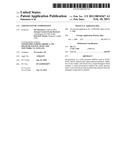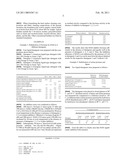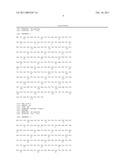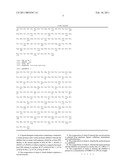Patent application title: Liquid Enzyme Composition
Inventors:
Ole Simonsen (Soeborg, DK)
Ole Simonsen (Soeborg, DK)
Juergen Carsten Franz Knoetzel (Copenhagen Oe, DK)
Lone Kierstein Nielsen (Kongens Lyngby, DK)
IPC8 Class: AC11D3386FI
USPC Class:
510393
Class name: Cleaning compositions or processes of preparing (e.g., sodium bisulfate component, etc.) enzyme component of specific activity or source (e.g., protease, of bacterial origin, etc.) liquid composition (e.g., slurry, etc.)
Publication date: 2011-02-10
Patent application number: 20110034367
Claims:
1. A liquid detergent composition comprising a surfactant, a serine
protease and a serine protease inhibitor wherein the inhibitor has an
amino acid sequence which has at least 50% identity to the mature peptide
of SEQ ID NO: 1 (RASI), 2 (BASI) or 3 (WASI) or which comprises a
sequence having at least 50% identity to residues 68-97 of SEQ ID NO: 1,
67-96 of SEQ ID NO: 2 or 67-96 of SEQ ID NO: 3.
2. The composition of claim 1, which further comprises a second enzyme,
3. The composition of claim 2 wherein the second enzyme is selected from amylases, lipases, cellulases, mannanases and oxidoreductases.
4. The composition of claim 1, wherein the serine protease is a subtilisin.
5. The composition of claim 1, wherein the serine protease and the inhibitor are present in a molar ratio of 1:100 to 1:1.
6. The composition of claim 1, wherein the inhibitor is present at a concentration of 0.0001% to 10% by weight.
Description:
REFERENCE TO A SEQUENCE LISTING
[0001]This application contains a Sequence Listing in computer readable form. The computer readable form is incorporated herein by reference.
FIELD OF THE INVENTION
[0002]The present invention relates to a liquid detergent composition comprising a surfactant, a serine protease and a protease inhibitor.
BACKGROUND OF THE INVENTION
[0003]Proteases, especially serine proteases such as subtilisins, are widely used as ingredients in commercial detergents. A major problem in formulating protease-containing detergents, especially liquid detergents, is that of ensuring enzyme stability during storage.
[0004]WO 1992/003529 (Novo Nordisk) discloses a detergent composition comprising a protease and one or more other enzymes, as well as comprising a reversible protease inhibitor of the peptide or protein type, particularly an inhibitor of family VI.
[0005]WO 1992/005239 (Novo Nordisk) discloses a detergent composition and additive comprising a protease and a reversible protease inhibitor of the peptide or protein type, wherein the ratio of dissociation constant to the protease concentration in the range from 0.006 to 6. When the protease is subtilisin, the protease inhibitor is preferably a modified subtilisin inhibitor of Family VI.
[0006]BASI, RASI and WASI (barley, rice and wheat alpha-amylase/subtilisin inhibitor) are described by B. C. Bonsager et al., The Journal of Biological Chemistry, vol. 280, pp. 14855-14864 (2005); and T. Yamasaki et al., Biosci. Biotechnol. Biochem., 70 (5), 1200-1209 (2006).
SUMMARY OF THE INVENTION
[0007]The inventors have found that incorporation of a serine protease inhibitor such as RASI, BASI, WASI (bifunctional alpha-amylase/subtilisin inhibitors of rice, barley and wheat) into a liquid detergent which contains a serine protease can stabilize the serine protease and/or a second enzyme and can release the enzyme when the detergent composition is diluted.
[0008]Accordingly, the invention provides a liquid detergent composition comprising a surfactant, a serine protease and a serine protease inhibitor wherein the inhibitor has an amino acid sequence such as RASI, BASI, or WASI or a homologue with at least 50% identity.
DETAILED DESCRIPTION OF THE INVENTION
Serine Protease Inhibitor
[0009]The serine protease inhibitor is a polypeptide which may have the amino acid sequence of RASI, BASI or WASI (SEQ ID NO: 1, 2 or 3), or it may be a close homologue of any of these. Thus, the inhibitor may have at least 50% identity to the mature peptide or it may comprise a sequence having at least 50% identity to residues 68-97 of SEQ ID NO: 1 (RASI), 67-96 of SEQ ID NO: 2 (BASI) or 67-96 of SEQ ID NO: 3. The identity may particularly be at least 60%, at least 70%, at least 80%, at least 85%, at least 90%, at least 95% or at least 98%.
Sequence Identity
[0010]The degree of identity between two amino acid sequences is calculated as the number of exact matches in an alignment of the two sequences, divided by the length of the shorter of the two sequences. The result is expressed in percent identity. An exact match occurs when the two sequences have identical amino acid residues in the same positions of the overlap. The length of a sequence is the number of amino acid residues in the sequence.
[0011]The alignment of the two amino acid sequences may be determined by using the Needle program from the EMBOSS package (http://emboss.org) version 2.8.0. The Needle program implements the global alignment algorithm described in Needleman, S. B. and Wunsch, C. D. (1970) J. Mol. Biol. 48, 443-453. The substitution matrix used is BLOSUM62, gap opening penalty is 10, and gap extension penalty is 0.5.
[0012]Alternatively, the alignment may be done by using the MegAlign program (version 7) developed by DNASTAR Inc., part of the Lasergene suite, based on Hein, J. J. (1990). "Unified approach to alignment and phylogenies." In Methods in Enzymology, Vol. 183: pp. 626-645. Using the Jotun Hein Method and the settings GAP PENALTY=11, GAP LENGTH PENALTY=3 for multiple alignments and KTUPLE=2 for pairwise alignments a series of percentage identity values can be calculated.
Serine Protease
[0013]The serine protease may be of animal, vegetable or microbial origin. It may be a serine protease, preferably an alkaline microbial protease or a trypsin-like protease. Examples of serine proteases are subtilisins, especially those derived from Bacillus, e.g., subtilisin Novo, subtilisin Carlsberg, subtilisin BPN', subtilisin 309, subtilisin 147 and subtilisin 168 (described in WO 89/06279). Examples of trypsin-like proteases are trypsin (e.g. of porcine or bovine origin) and the Fusarium protease described in WO 89/06270.
[0014]Examples of commercially available serine proteases (peptidases) include Kannase®, Everlase®, Esperase®, Alcalase®, Neutrase®, Durazym®, Savinase®, Ovozyme®, Liquanase®, Polarzyme®, Pyrase®, Pancreatic Trypsin NOVO (PTN), Bio-Feed® Pro and Clear-Lens® Pro (all available from Novozymes A/S, Bagsvaerd, Denmark). Preferred serine proteases include those described in WO 1998/020115, WO 01/44452, WO 01/58275, WO 01/58276, WO 2003/006602, and WO 2004/099401.
[0015]Other commercially available serine proteases include Ronozyme® Pro, Maxatase®, Maxacal®, Maxapem®, Opticlean®, Properase®, Purafect®, Purafect Ox® and Purafact Prime® (available from Genencor International Inc., Gist-Brocades, BASF, or DSM Nutritional Products).
Optional Second Enzyme
[0016]In addition to the serine protease, the liquid composition may optionally comprise one or more other enzymes, e.g. selected among amylases, lipolytic enzymes (particularly lipases), cellulases, mannanases and oxidoreductases.
[0017]The amylase may be an alpha-amylase of bacterial or fungal origin, e.g. an alpha-amylase from B. licheniformis, described in GB 1,296,839. Commercially available amylases are Duramyl®, Termamyl®, Stainzyme®, Stainzyme Plus®, Termamyl Ultra®, Fungamyl® and BAN® (available from Novozymes NS) and Rapidase®, Maxamyl P®, Purastar and Purastar OxAm (available from Gist-Brocades and Genencor Inc.).The cellulase may be of bacterial or fungal origin. It may be a fungal cellulase from Humicola insolens (U.S. Pat. No. 4,435,307) or from Trichoderma, e.g. T. reesei or T. viride. Examples of cellulases are described in EP 0 495 257. Commercially available cellulases include Carezyme®, Celluzyme®, Endolase® (available from Novozymes), Puradax, Puradax HA, and Puradax EG (available from Genencor).
[0018]The oxidoreductase may be a peroxidase or an oxidase such as a laccase. The peroxidase may be of plant, bacterial or fungal origin. Examples are peroxidases derived from a strain of Coprinus, e.g., C. cinerius or C. macrorhizus, or from a strain of Bacillus, e.g., B. pumilus, particularly peroxidase according to WO 91/05858. Suitable laccases herein include those of bacterial or fungal origin. Examples are laccases from Trametes, e.g., T. villosa or T. versicolor, or from a strain of Coprinus, e.g., C. cinereus, or from a strain of Myceliophthora, e.g., M. thermophila.
[0019]The lipolytic enzyme may be a lipase or cutinase of bacterial or fungal origin. Examples include a lipase from Thermomyces lanuginosus (Humicola lanuginosa) described in EP 258 068 and EP 305 216, a Rhizomucor miehei lipase, e.g., as described in EP 238 023, a Candida lipase, such as a C. antarctica lipase, e.g., the C. antarctica lipase A or B described in EP 214 761, a Fusarium oxysporum lipase (WO 98/26057), a Pseudomonas lipase such as a P. pseudoalcaligenes and P. alcaligenes lipase, e.g., as described in EP 218 272, a P. cepacia lipase, e.g., as described in EP 331 376, a P. stutzeri lipase, e.g., as disclosed in BP 1,372,034, a P. fluorescens lipase, a Bacillus lipase, e.g., a B. subtilis lipase (Dartois et al., (1993), Biochemica et Biophysica acta 1131, 253-260), a B. stearothermophilus lipase (JP 64/744992), B. pumilus lipase (WO 91/16422), Penicillium camenbertii lipase (Yamaguchi et al., (1991), Gene 103, 61-67), the Geotrichum candidum lipase (Shimada, Y. et al., (1989), J. Biochem. 106, 383-388), and various Rhizopus lipases such as a R. delemar lipase (Hass,
[0020]M. J et al., (1991), Gene 109, 117-113), a R. niveus lipase (Kugimiya et al., (1992), Biosci. Biotech. Bio-chem. 56, 716-719) and a R. oryzae lipase. Additional examples are cutinase from Pseudomonas mendocina (WO 88/09367), cutinase from Fusarium solani pisi (WO 90/09446) and cutinase from Humicola insolens (WO 2001/092502). The lipolytic enzyme may be a lipase variant, e.g. described in WO 2000/060063.
[0021]Examples of commercially available lipases include Lipex®, Lipoprime®, Lipopan®, Lipopan F®, Lipopan Xtra®, Lipolase®, Lipolase® Ultra, Lipozyme®, Palatase®, Resinase®, Novozym® 435 and Lecitase® (all available from Novozymes A/S). Other commercially available lipases include Lumafast® (Pseudomonas mendocina lipase from Genencor International Inc.); Lipomax® (Ps. pseudoalcaligenes lipase from Gist- Brocades/Genencor Int. Inc.; and Bacillus sp. lipase from Solvay enzymes. Further lipases are available from other suppliers such as Lipase P "Amano" (Amano Pharmaceutical Co. Ltd.).
[0022]Examples of mannanases include MannawayTM (product of Novozymes) and MannaStar (product of Genencor).
Liquid Detergent Composition
[0023]The invention is particularly applicable to the formulation of liquid detergents where enzyme stability problems are pronounced. The liquid detergent may be aqueous, typically containing 20-70% water and 0-20% organic solvent (hereinafter, percentages by weight).
[0024]The detergent comprises a surfactant which may be anionic, non-ionic, cationic, amphoteric or a mixture of these types. The detergent will usually contain 5-30% anionic surfactant such as linear alkyl benzene sulphonate (LAS), alpha-olefin sulphonate (AOS), alcohol ethoxy sulphate (AES) or soap. It may also contain 3-20% anionic surfactant such as nonyl phenol ethoxylate or alcohol ethoxylate.
[0025]The pH (measured in aqueous detergent solution) will usually be neutral or alkaline, e.g. 7-10. The detergent may contain 1-40% of a detergent builder such as zeolite, phosphate, phosphonate, citrate, NTA, EDTA or DTPA, or it may be unbuilt (i.e. essentially free of a detergent builder). It may also contain other conventional detergent ingredients, e.g. fabric conditioners, foam boosters, bactericides, optical brighteners and perfumes.
[0026]The detergent composition may be a fabric cleaning compositions, hard surface cleansing compositions, light duty cleaning compositions including dish cleansing compositions and automatic dishwasher detergent compositions.
[0027]The liquid composition may comprise from about 0.0001% to about 10%, more particularly from about 0.001% to about 1%, and most particularly from about 0.01% to about 0.1% of the inhibitor.
[0028]The molar ratio of the inhibitor to the serine protease may be from about 100:1 to about 1:1, more particularly from about 10:1 to about 1.5:1, and most particularly about 3:1.
[0029]Thus, a stabilized liquid enzyme formulation typically contains 1-10% by weight of enzyme protein (total of serine protease and optional second enzyme) and 2-25% by weight of the inhibitor
[0030]A liquid detergent formulation will typically contain 0.04-40 micromolar enzyme or 1-1000 mg/l of pure enzyme protein and about 3 times more of the inhibitor, i.e. 0.12-120 micromolar of inhibitor.
[0031]The liquid detergent composition may contain water and other solvents as carriers. Low molecular weight primary or secondary alcohols exemplified by methanol, ethanol, propanol, and iso-propanol are suitable. Monohydric alcohols are preferred for solubilizing surfactants, but polyols such as those containing from about 2 to about 6 carbon atoms and from about 2 to about 6 hydroxy groups (e.g., 1,3-propanediol, ethylene glycol, glycerine, and 1,2-propanediol) can also be used. The compositions may contain from about 5% to about 90%, typically from about 10% to about 50% of such carriers.
[0032]The detergent compositions herein will preferably be formulated such that during use in aqueous cleaning operations, the wash water will have a pH between about 6.8 and about 11. Finished products are typically formulated at this range. Techniques for controlling pH at recommended usage levels include the use of, for example, buffers, alkalis, and acids. Such techniques are well known to those skilled in the art.
[0033]When formulating the hard surface cleaning compositions and fabric cleaning compositions of the present invention, the formulator may wish to employ various builders at levels from about 5% to about 50% by weight. Typical builders include the 1-10 micron zeolites, polycarboxylates such as citrate and oxydisuccinates, layered silicates, phosphates, and the like. Other conventional builders are listed in standard formularies.
EXAMPLES
Example 1: Stabilization of Savinase by BASI in 4 different detergents
[0034]Four liquid detergents were prepared with the compositions shown below:
[0035]Detergent 1 (American liquid-type detergent without LAS) Dosage in Assay:1.5g/L.
[0036]Detergent 2 (American liquid-type detergent with LAS) Dosage in Assay:1.5g/L.
[0037]Detergent 3 (European liquid-type detergent without LAS) Dosage in Assay: 6g/L.
[0038]Detergent 4 (European liquid-type detergent with LAS) Dosage in Assay: 6g/L.
TABLE-US-00001 Component, % w/w Det 1 Det 2 Det 3 Det 4 Sodium alkylethoxy sulphate (C9-15, 2EO) 14.0 7.4 Sodium dodecyl benzene sulphonate (LAS) 5.5 10.0 Sodium lauryl sulphate 17.0 Sodium toluene sulphonate 3.0 1.0 3.0 1.0 Sodium xylene sulphonate 4.4 Oleic acid 4.0 10.0 13.0 Primary alcohol ethoxylate (C12-15, 7EO) 2.5 3.0 5.0 7.0 Primary alcohol ethoxylate (C12-15, 3EO) 2.0 2.5 4.0 6.0 Ethanol 2.1 1.0 3.0 4.0 Sodium carbonate 4.5 4.0 0.5 Tri-sodium citrate 2H2O 5.0 2.0 4.5 1.0 pH (adjusted with NaOH) 8.0 9.0 9.0 9.0 De-ionized water: ad 100%
[0039]An inhibitor assay was conducted as follows:
[0040]100 micro-L Savinase (1 micro-g/ml, 37 nM) and 100 micro-L buffer (50mM Glycine, 150mM KCl, 0.05mM CaCl2, 0.01Triton X-100, pH 9.8) was incubated for 30 min at room temperature in the absence or presence of detergents 1, 2, 3 or 4 (minus inhibitor). 100 micro-L Savinase (1 μg/ml, 37 nM) and 100 micro-L BASI (13,8 micro-g/ml, 690 nM) was incubated for 30 min at room temperature in the absence or presence of detergents 1, 2, 3 or 4 (plus inhibitor).
[0041]Subsequently, 50 micro-L dissolved 4.8 mM serine protease substrate Suc-Ala-Ala-Pro-Phe-pNA (Sigma S-7388) in 50 mM Glycine, pH 9.8 was added, and the activity was measured at 405 nm over 7 min. Results are expressed as residual activity compared to the Savinase activity in the absence of inhibitor in detergent 1, 2, 3, or 4.
TABLE-US-00002 Without inhibitor With inhibitor Residual activity No detergent 339 42 12% Detergent 1 324 40 12% Detergent 2 290 44 15% Detergent 3 322 42 13% Detergent 4 281 44 16%
[0042]The results show that BASI inhibits Savinase efficiently in the absence of detergents and equally well in the presence of detergents 1, 2, 3, and 4. Thus, the inhibition efficiency of BASI is not influenced by the presence of LAS in detergents 2 and 4 as can be seen from the almost identical results for the respective detergents 1 and 3 without LAS.
Example 2: Stabilization of serine protease and lipase
[0043]Two liquid detergents were prepared as follows:
TABLE-US-00003 Reference BASI detergent Component detergent (0.044% BASI) Detergent base 3 (Example 1) 22.0 g 22.0 g Serine protease (Savinase 16.0 LEX) 0.12 g 0.12 g Lipase (Lipex 100 L) 0.12 g 0.12 g De-ionized water 2.9 g BASI-solution (2.56 mg/ml) 4.6 g
[0044]The detergents were placed in closed glasses at 30° C. and 35° C. Residual activity of lipase and serine protease was measured (by comparison to a reference stored at -18° C.) at different times (serine protease measured by hydrolysis of N,N-dimethylcasein at 40° C., pH 8.3 and lipase measured by hydrolysis of p-nitrophenyl valerate at 40° C., pH 7.7).
TABLE-US-00004 % residual activity Residual serine protease activity Residual lipase activity 3 days 1 week 2 weeks 3 days 1 week Detergent 30° C. 35° C. 35° C. 30° C. 35° C. Reference 63 2.3 0.4 25 3.3 0.044% BASI 96 78 48 86 31
[0045]From the table it is clearly seen that BASI significantly stabilizes both enzymes
Sequence CWU
1
31200PRTOryza sativamat_peptide(23)..(200) 1Met Val Ser Leu Arg Leu Pro
Leu Ile Leu Leu Ser Leu Leu Ala Ile -20 -15
-10Ser Phe Ser Cys Ser Ala Ala Pro Pro Pro Val Tyr Asp Thr Glu
Gly -5 -1 1 5 10His Glu
Leu Ser Ala Asp Gly Ser Tyr Tyr Val Leu Pro Ala Ser Pro
15 20 25Gly His Gly Gly Gly Leu Thr Met
Ala Pro Arg Val Leu Pro Cys Pro 30 35
40Leu Leu Val Ala Gln Glu Thr Asp Glu Arg Arg Lys Gly Phe Pro
Val 45 50 55Arg Phe Thr Pro Trp
Gly Gly Ala Ala Ala Pro Glu Asp Arg Thr Ile 60 65
70Arg Val Ser Thr Asp Val Arg Ile Arg Phe Asn Ala Ala Thr
Ile Cys75 80 85 90Val
Gln Ser Thr Glu Trp His Val Gly Asp Glu Pro Leu Thr Gly Ala
95 100 105Arg Arg Val Val Thr Gly Pro
Leu Ile Gly Pro Ser Pro Ser Gly Arg 110 115
120Glu Asn Ala Phe Arg Val Glu Lys Tyr Gly Gly Gly Tyr Lys
Leu Val 125 130 135Ser Cys Arg Asp
Ser Cys Gln Asp Leu Gly Val Ser Arg Asp Gly Ala 140
145 150Arg Ala Trp Leu Gly Ala Ser Gln Pro Pro His Val
Val Val Phe Lys155 160 165
170Lys Ala Arg Pro Ser Pro Pro Glu 1752203PRTHordeum
vulgaremat_peptide(24)..(203) 2Met Gly Ser Arg Arg Ala Gly Ser Ser Ser
Ser Pro Leu Phe Trp Pro -20 -15
-10Ala Pro Pro Ser Arg Ala Ala Asp Pro Pro Pro Val His Asp Thr Asp
-5 -1 1 5Gly His Glu Leu Arg Ala Asp Ala Asn
Tyr Tyr Val Leu Ser Ala Asn10 15 20
25Arg Ala His Gly Gly Gly Leu Thr Met Ala Pro Gly His Gly
Arg His 30 35 40Cys Pro
Leu Phe Val Ser Gln Asp Pro Asn Gly Gln His Asp Gly Phe 45
50 55Pro Val Arg Ile Thr Pro Tyr Gly Val
Ala Pro Ser Asp Lys Ile Ile 60 65
70Arg Leu Ser Thr Asp Val Arg Ile Ser Phe Arg Ala Tyr Thr Thr Cys 75
80 85Leu Gln Ser Thr Glu Trp His Ile Asp
Ser Glu Leu Ala Ala Gly Arg90 95 100
105Arg His Val Ile Thr Gly Pro Val Lys Asp Pro Ser Pro Ser
Gly Arg 110 115 120Glu Asn
Ala Phe Arg Ile Glu Lys Tyr Ser Gly Ala Glu Val His Glu 125
130 135Tyr Lys Leu Met Ser Cys Gly Asp Trp
Cys Gln Asp Leu Gly Val Phe 140 145
150Arg Asp Leu Lys Gly Gly Ala Trp Phe Leu Gly Ala Thr Glu Pro Tyr
155 160 165His Val Val Val Phe Lys Lys
Ala Pro Pro Ala170 175 1803180PRTTriticum
aestivum 3Asp Pro Pro Pro Val His Asp Thr Asp Gly Asn Glu Leu Arg Ala
Asp1 5 10 15Ala Asn Tyr
Tyr Val Leu Pro Ala Asn Arg Ala His Gly Gly Gly Leu 20
25 30Thr Met Ala Pro Gly His Gly Arg Arg Cys
Pro Leu Phe Val Ser Gln 35 40
45Glu Ala Asp Gly Gln Arg Asp Gly Leu Pro Val Arg Ile Ala Pro His 50
55 60Gly Gly Ala Pro Ser Asp Lys Ile Ile
Arg Leu Ser Thr Asp Val Arg65 70 75
80Ile Ser Phe Arg Ala Tyr Thr Thr Cys Val Gln Ser Thr Glu
Trp His 85 90 95Ile Asp
Ser Glu Leu Val Ser Gly Arg Arg His Val Ile Thr Gly Pro 100
105 110Val Arg Asp Pro Ser Pro Ser Gly Arg
Glu Asn Ala Phe Arg Ile Glu 115 120
125Lys Tyr Ser Gly Ala Glu Val His Glu Tyr Lys Leu Met Ala Cys Gly
130 135 140Asp Ser Cys Gln Asp Leu Gly
Val Phe Arg Asp Leu Lys Gly Gly Ala145 150
155 160Trp Phe Leu Gly Ala Thr Glu Pro Tyr His Val Val
Val Phe Lys Lys 165 170
175Ala Pro Pro Ala 180
User Contributions:
Comment about this patent or add new information about this topic:
| People who visited this patent also read: | |
| Patent application number | Title |
|---|---|
| 20200168975 | N-WAY RING COMBINER/DIVIDER |
| 20200168974 | TRANSITION ARRANGEMENT, A TRANSITION STRUCTURE, AND AN INTEGRATED PACKAGED STRUCTURE |
| 20200168973 | RADIO FREQUENCY (RF) CONNECTION ASSEMBLY INCLUDING A PIN AND BEAD ASSEMBLY WITH A SMOOTH INNER EDGE |
| 20200168972 | MMWAVE DIELECTRIC WAVEGUIDE INTERCONNECT TOPOLOGY FOR AUTOMOTIVE APPLICATIONS |
| 20200168971 | RESIN WITH PLATING LAYER AND METHOD OF MANUFACTURING THE SAME |




